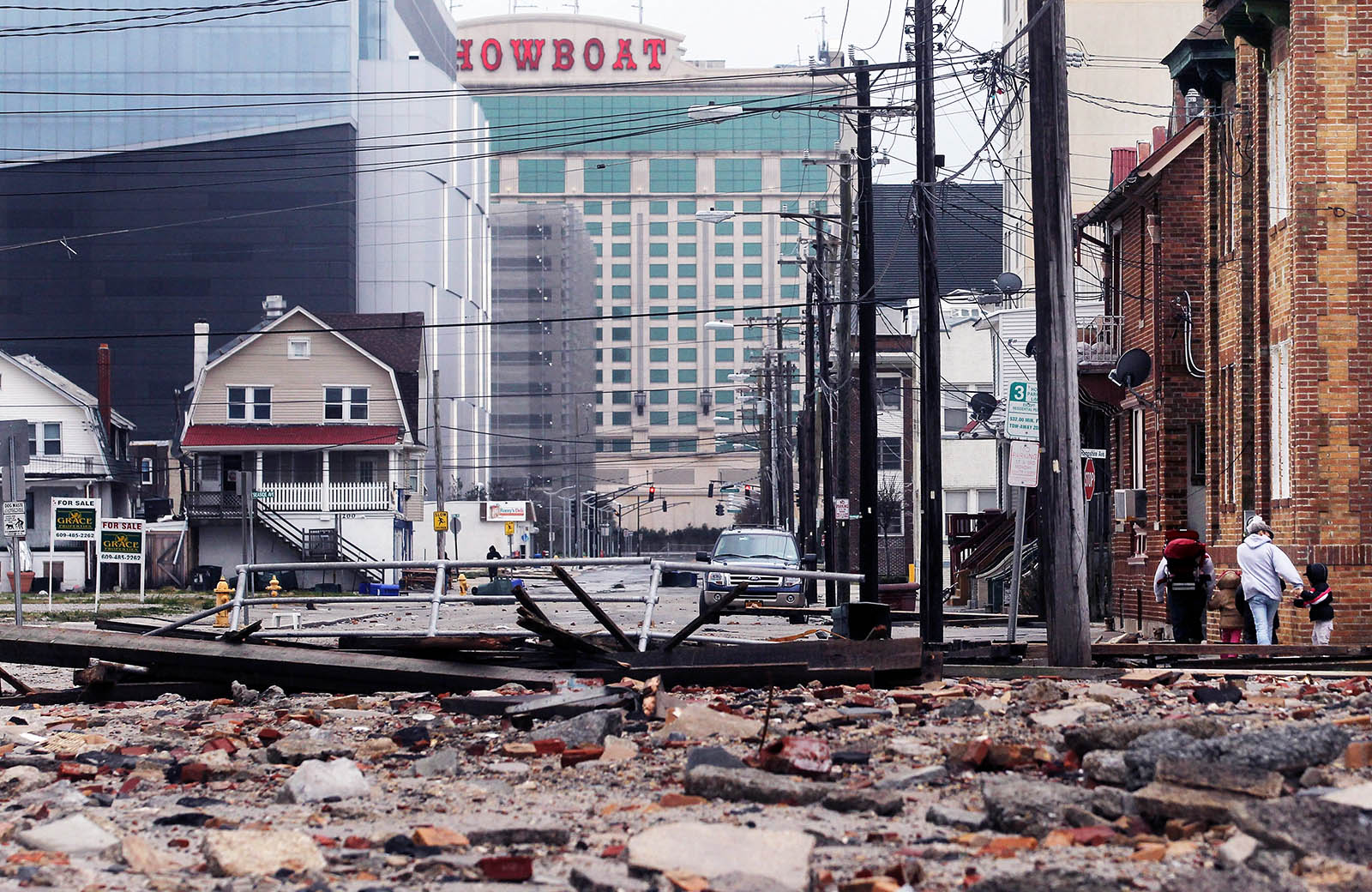Parametric Insurance Can Boost Resilience for the Public Sector

People walk past flooding disaster caused by Hurricane Sandy in New Jersey. Responding to climate change, and the rapidly evolving landscape of environmental risks more broadly, will require financial tools that allow for adaptability and speedy responses.
Photo: Mario Tama/Getty Images
In the wake of a natural disaster, traditional insurance can help restore insured assets to their status prior to the loss. It may not always be desirable, however, to restore a situation that led to a vulnerable state in the first place. The public may want — and need — to create new approaches to urban planning, construction or water management that leverage lessons from the disaster. Indeed, “building back better” is fundamental to reducing future disaster risk, but traditional insurance can only support building back what was there before.
Parametric insurance can help fill this gap. This type of insurance pays out when certain predetermined conditions (or parameters), which strongly correlate with losses, are met. We know, for instance, that wildfire-driven losses can be approximated by the location and size of the burnt area. Similarly, hurricane-driven losses correlate with the storm’s track, movement speed and wind and storm surge intensity. If a natural hazard exceeds a certain threshold for such parameters, insurance companies can assume that a certain loss has occurred — circumventing the need for a lengthy claims process. This offers an important advantage for public and private entities alike; however, here we focus on how public agencies specifically can garner control of the conditions for payment if they know what these should be.
This means that after a disaster, parametric insurance can quickly and transparently provide funds for response and recovery operations. Moreover, the absence of conditions for how funds should be spent means that public agents can disburse funds as the situation demands. Thus, while traditional insurance can play an important role post-disaster, parametric insurance provides the public sector with additional flexibility, boosting adaptability and resilience.
Climate Change and Parametric Insurance
Responding to climate change, and the rapidly evolving landscape of environmental risks more broadly, will require financial tools that allow for adaptability and speedy responses. Parametric solutions are particularly well-placed to help manage these risks. They disentangle the two most important components of natural hazards, which are typically considered jointly: impact and frequency.
Over the last two decades, governments around the world have developed various parametric solutions to complement their catastrophe risk management frameworks.
Public agents are uniquely positioned to lead the work of defining hazard parameters and their values, as they are intimately aware of the existing vulnerabilities of their systems. The markets, on the other hand, dictate pricing according to how frequently they perceive these hazards to occur. As we learn more about climate change, we expect frequencies to rise in some instances — more frequent wildfires in California — and decrease in others — less frequent snowstorms. This implies that pricing of parametric solutions will evolve accordingly. Parametric solutions allow public agencies to clearly determine the scenarios for which they need protection, while markets transparently price the coverage according to their understanding of event frequency.
Governments Around the World Are Embracing Parametric Solutions
Over the last two decades, governments around the world have developed various parametric solutions to complement their catastrophe risk management frameworks, often with support from the World Bank. Governments such as Mexico, India, Peru, Chile, Colombia and the Philippines have done so individually, while those in other parts of the world have done so regionally: the five-member Pacific Catastrophe Risk Assessment & Financing Initiative, the 19-member Caribbean Catastrophe Risk Insurance Facility and the 34-member African Risk Capacity facility.
Many of these financial products have produced payments throughout their history.
One of the largest, most recent payouts was the full recovery of the $150 million earthquake limit of the Mexican IBRD/FONDEN 2017 cat bond. After the Chiapas 8.1 magnitude event on September 8, 2017, the funds were disbursed about 70 days after the event with an aim to support the Mexican government in early recovery operations. While the payout was relatively fast, it is not representative of the average: For solutions that do not involve complex catastrophe bond structures, payouts can take place in a week or two — and sometimes in a matter of days.
Meanwhile, in New York, the Metropolitan Transportation Authority (MTA) has tapped the reinsurance markets for capacity in 2013, 2017 and, more recently, in 2020 via the MetroCat Re cat bond. After witnessing the significant impact of Hurricane Sandy in 2012 on New York’s subway system, the MTA chose a parametric mechanism that triggers payments when the storm surge reaches a particular water depth at select measurement stations around New York Bay. The stations are highly correlated with expected flooding at MTA’s vulnerable infrastructure locations. This system is designed to provide a cash influx to the MTA of $100 million (in the latest 2020 issuance) if those conditions materialize, allowing them to deploy funds as required to repair infrastructure or respond to the emergency.
Governments Shouldn’t Wait to Design Parametric Tools
Authorities don’t need to wait for catastrophe to strike before realizing the benefits of parametric tools. New York City began using parametric tools after learning from the destruction of Hurricane Sandy, but the city’s flood hazards had in fact been pointedly estimated one year before the storm in the ClimAID report sponsored by the New York State Energy Research and Development Authority. Indeed, there already exist many studies — often sponsored with public funds, no less — that identify the characteristics of potentially devastating events. These could support public entities in designing parametric mechanisms.
A case in point is the ShakeOut 7.8 magnitude scenario in Southern California, a considerable multilateral effort to study the potential consequences of a large earthquake near Los Angeles published in 2008. The study asserts that this type of event, unmitigated, would “cause some 2,000 deaths, 50,000 injuries, $200 billion in damage, and severe, long-lasting disruption.” The 312-page report contains a wealth of information identifying the characteristics of earthquakes that could trigger financial ruin and thus are prime candidates for parametric risk transfer solutions. Public agents can leverage these studies to define and tailor parametric coverage solutions that could contribute to supporting a clearly unprepared Californian population, which currently has a pitifully low earthquake insurance take up of about 10%.
Insurance for a Future-Ready Public Sector
Where traditional insurance limits recovery to restoring particular assets, parametric insurance empowers the public sector with flexible, timely funds for both disaster response and “building back better.” As climate change continues to make extreme weather events more frequent and intense, resilience and flexibility will be more important than ever.





